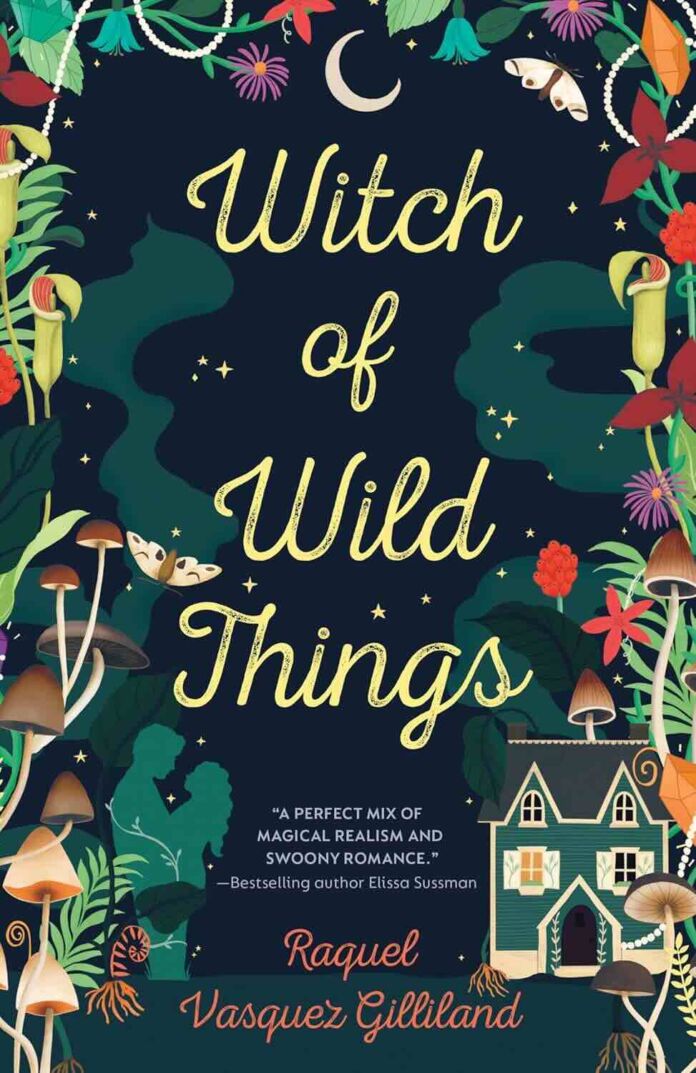In her adult fantasy romance debut, Pura Belpré Award-winning author Raquel Vasquez Gilliland weaves a mesmerizing tale set in the charming coastal town of Cranberry, Virginia. Known for her young adult novels like “Sia Martinez and the Moonlit Beginning of Everything” and “How Moon Fuentez Fell in Love with the Universe,” Gilliland brings her signature blend of magical realism and rich cultural elements to Witch of Wild Things, an enchanting story about family curses, second chances, and the profound connection between humans and nature.
The Magic System & World-Building
One of the novel’s strongest elements is its unique approach to magic. The Flores women’s gifts feel both whimsical and grounded—from Teal’s ability to control weather to Sky’s connection with animals, and protagonist Sage’s talent for communicating with plants. Gilliland creates a world where magic exists in subtle ways, seamlessly woven into everyday life rather than dominating it.
The setting of Cranberry is lovingly crafted, with vivid descriptions of heritage rose gardens, ancient forests, and seaside cliffs. The author’s extensive knowledge of botany and folklore enriches the narrative, making the fictional town feel authentic and lived-in.
Plot & Pacing
The story follows Sage Flores, who returns home after losing her teaching position, only to confront unresolved family trauma and a second chance at love with her high school crush, Tennessee Reyes. While the plot’s framework might seem familiar to romance readers, Gilliland infuses it with unique elements that keep readers engaged.
However, the pacing occasionally feels uneven. The first third of the book moves slowly as it establishes the complex family dynamics and backstory. Once the plant-hunting adventure with Tenn begins, the story finds its rhythm, though some subplots (like the mysterious blue rose) feel underdeveloped.
Character Development
Strengths:
- Sage is a compelling protagonist whose journey of healing and self-discovery feels authentic
- The complex sisterly relationship between Sage, Teal, and Sky is beautifully portrayed
- Supporting characters like Laurel and Nadia are well-developed with their own meaningful arcs
Areas for Improvement:
- Tennessee’s character sometimes lacks depth beyond his role as the love interest
- Some secondary characters, particularly the antagonists, tend toward one-dimensionality
Romance Elements
The second-chance romance between Sage and Tenn is sweet and steamy in equal measure. Their shared history through AOL Instant Messenger adds a nostalgic touch that many readers will appreciate. However, the conflict keeping them apart—based largely on a misunderstanding from their teenage years—might frustrate some readers who prefer more substantial romantic obstacles.
Themes & Cultural Elements
Gilliland expertly explores themes of:
- Family legacy and intergenerational trauma
- Environmental conservation and humanity’s connection to nature
- The power of forgiveness and healing
- Mexican American culture and folklore
Writing Style
The prose is lyrical and atmospheric, particularly when describing the natural world. Gilliland has a gift for sensory details that make scenes come alive. However, some metaphors feel overworked, and dialogue occasionally veers into exposition.
Critical Analysis
What Works Well:
- The unique blend of botanical knowledge with magical elements
- Strong family dynamics and sister relationships
- Atmospheric writing that creates a strong sense of place
- Thoughtful exploration of grief and healing
Room for Improvement:
- Some plot threads feel unresolved or rushed
- The central conflict could be stronger
- Occasional pacing issues
- The villain’s motivations could be more nuanced
Comparable Titles
Readers who enjoy “Witch of Wild Things” might also like:
- “The Very Secret Society of Irregular Witches” by Sangu Mandanna
- “Garden Spells” by Sarah Addison Allen
- “The Nature of Witches” by Rachel Griffin
Final Verdict
“Witch of Wild Things” is a promising adult debut that will appeal to readers who enjoy their romance with a heavy dose of magical realism and family drama. While it has some first-book stumbles, Gilliland’s unique voice and imaginative magic system make it a worthwhile read, particularly for those interested in botanical magic and sister stories.
The novel’s greatest strength lies in its heart—the authentic exploration of family relationships, the tender romance, and the deep connection to nature. Though not perfect, it’s a charming addition to the contemporary fantasy romance genre that leaves readers eager for the sequel, “Lightning in Her Hands.”
Perfect For Readers Who:
- Love magical realism with strong family themes
- Enjoy romantic stories with botanical elements
- Appreciate diverse representation in fantasy
- Are interested in plant lore and nature magic
- Like second-chance romance tropes
Content Advisories
- Mild language
- Some sexual content
- Themes of grief and family trauma
- References to domestic abuse
The book effectively balances its various elements—romance, magic, family drama—while maintaining its unique voice and perspective. Despite its flaws, it’s a promising start to what could be a memorable series about the magical Flores women.





